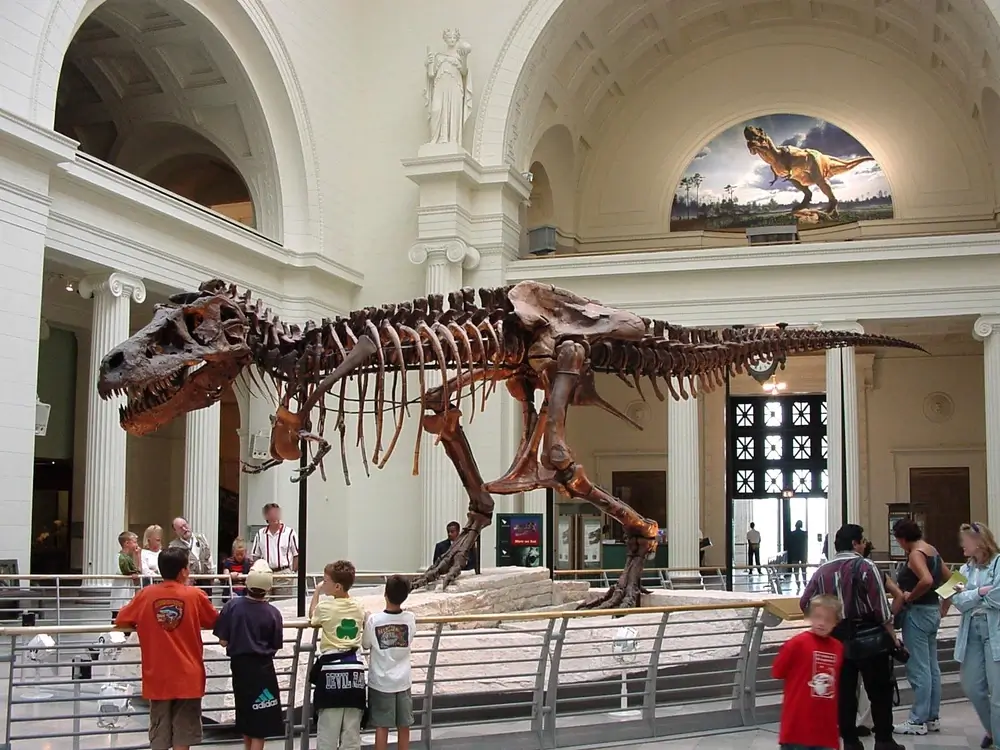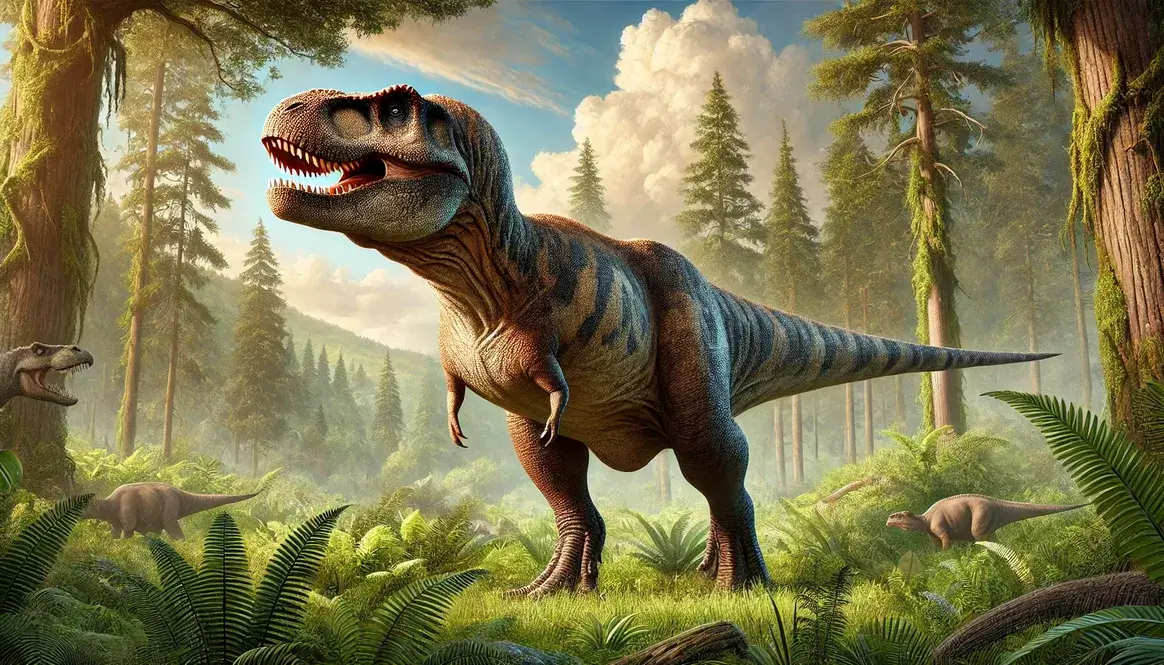In the world of dinosaur discoveries, one name stands out: Sue. This colossal Tyrannosaurus rex skeleton isn’t just big—it’s the biggest T. rex skeleton ever found, it’s also the most complete. Sue’s discovery shook up the paleontology world and gave us a whole new look at these amazing prehistoric creatures. Let’s dig into the story of how Sue was found and why this skeleton is such a big deal.
The Discovery of Sue
Sue’s discovery is a tale of luck, sharp eyes, and perfect timing. It all started on a hot summer day in South Dakota, setting the stage for one of the most important fossil finds in history.
The Fateful Day
On August 12, 1990, the dinosaur world changed forever. Sue Hendrickson, a fossil hunter, was exploring the Cheyenne River Indian Reservation in South Dakota. While the rest of her team was fixing a flat tire, Sue noticed some bones sticking out of a cliff. Little did she know, she had just stumbled upon the find of a lifetime!
Initial Excavation
Getting Sue out of the ground was no walk in the park. The team faced numerous challenges, from the fragile nature of the bones to the scorching heat. But with careful planning and quick work, they managed to unearth a prehistoric treasure.
The team had to:
- Carefully remove layers of rock and dirt
- Map out where each bone was found
- Wrap the bones in protective material
But they faced some tricky challenges:
- The bones were fragile and could easily break
- The weather was scorching hot, making work tough
- They had to work fast before the landowner changed their mind about the dig
Despite these hurdles, the team managed to get Sue out of the ground in just 17 days. Talk about speedy!

Sue’s Unique Features
Sue isn’t just another dinosaur skeleton. This T. rex has some truly special features that make it stand out in the world of paleontology. From its massive size to its unique battle scars, Sue has a lot to tell us about life in the Cretaceous period.
Size and Completeness
Sue isn’t just big—it’s massive. Here’s how Sue stacks up:
| Measurement | Size |
|---|---|
| Length | 40 feet (12.3 meters) |
| Height at the hips | 13 feet (4 meters) |
| Estimated weight | 9 tons (8,160 kg) |
But what really makes Sue special is how complete the skeleton is. Scientists found 90% of Sue’s bones, which is incredibly rare for a T. rex. This means we can learn so much more about how these dinosaurs looked and moved.
Distinctive Characteristics
Sue has some unique features that make this T. rex stand out:
- Huge skull: Sue’s skull is a whopping 5 feet (1.5 meters) long, packed with 58 teeth that are each the size of a banana!
- Battle scars: The skeleton shows signs of injuries that healed, telling us about the tough life of a T. rex.
- Wishbone: Sue has a furcula (wishbone), which was the first one ever found in a T. rex. This links T. rex more closely to modern birds.
Sue also had some health issues. Scientists found:
- Signs of arthritis in some joints
- A hole in the skull that might have been from an infection
- Broken ribs that had healed
These findings help us understand the life and times of T. rex better than ever before. Sue’s skeleton is like a prehistoric history book, telling us stories about life 67 million years ago!
Size Comparison
When we talk about big dinosaurs, Sue is always part of the conversation. This T. rex isn’t just impressive on its own—it’s a true giant even among its own kind. Let’s see how Sue measures up to other famous fossils.
Sue vs Other T. rex Specimens
Sue isn’t the only T. rex in town, but it’s certainly the biggest. Here’s how Sue compares to some other famous T. rex fossils:
| T. rex Specimen | Length | Completeness |
|---|---|---|
| Sue | 40 feet | 90% |
| Stan | 39 feet | 70% |
| Scotty | 39 feet | 65% |
| Trix | 43 feet (estimated) | 80% |
While Trix might be longer, Sue still takes the crown for completeness and overall size. It’s like comparing the tallest person in your school to the tallest person in the world—they’re all impressive, but Sue stands out from the pack.
Sue in the Context of Large Theropods
T. rex wasn’t the only big meat-eater in dinosaur times. While Sue is impressive, other theropods give it a run for its money. Giganotosaurus, for example, was slightly longer at 41-43 feet, though probably not as heavy. The crocodile-snouted Spinosaurus takes the cake for length, stretching up to 50-59 feet! Carcharodontosaurus, with its differently shaped skull, was similar in size to T. rex.
But here’s the kicker: despite these lengthy competitors, Sue and other T. rexes are still considered the heavyweight champions of the theropod world. Sue’s massive build helps us grasp just how enormous these prehistoric predators could get. It’s like comparing a heavyweight boxer to a basketball player—they’re both impressive, but in different ways!
Scientific Importance
Sue isn’t just a cool fossil—it’s a goldmine of scientific information. This skeleton has revolutionized our understanding of T. rex and pushed the boundaries of paleontological research.
Contributions to T. rex Research
Studying Sue has been like reading a prehistoric diary. Scientists have uncovered fascinating insights about T. rex life:
- Growth patterns: T. rex had teenage growth spurts! Sue’s bones show these dinos grew super fast in their teen years.
- Sensory abilities: With a great sense of smell and hearing, T. rex was the ultimate predator.
- Bite force: Sue’s jaw structure revealed T. rex had one of the strongest bites of any land animal ever.
These discoveries paint a picture of T. rex as a smart, fast-growing predator with senses sharp enough to rule the Cretaceous.
Technological Advancements
Sue’s discovery didn’t just teach us about dinosaurs—it sparked a tech revolution in paleontology. Scientists developed new ways to study fossils:
- CT scanning to peek inside bones
- 3D modeling to understand dino movement
- Synchrotron radiation to see the tiniest bone details
Thanks to Sue, these techniques are now used to study all sorts of fossils. Talk about a prehistoric trendsetter!
Public Education Value
Sue isn’t just a research superstar—this T. rex is also a fantastic teacher. From museum exhibits to social media, Sue has brought dinosaur science to the masses in exciting ways.
Millions have seen Sue at the Field Museum in Chicago, while traveling casts have taken the T. rex experience worldwide. And let’s not forget Sue’s hilarious Twitter account (@SUEtheTrex), making paleontology cool for a whole new generation.
By sparking curiosity in dinosaurs and science, Sue has become more than just a fossil. It’s a gateway to learning, inspiring countless future scientists and dinosaur enthusiasts. Who knew a 67-million-year-old skeleton could be such a great influencer?
The Legal Battle
Sue’s journey from the ground to the museum wasn’t all smooth sailing. In fact, it turned into a legal tussle that shook up the world of paleontology.
Ownership Dispute
As soon as Sue was unearthed, the question of “Who owns this dinosaur?” sparked a heated debate. The main players in this prehistoric property dispute were:
- The fossil hunters who found Sue
- Maurice Williams, the landowner
- The Cheyenne River Sioux Tribe
- The U.S. government
The core issue? Whether the land where Sue was found was private, tribal, or federal property. This wasn’t just about a dinosaur—it was about land rights and the value of scientific discoveries.
Court Proceedings
The legal battle over Sue lasted longer than a T. rex’s lifespan! Here’s how it played out:
- 1992: The FBI and National Guard seized Sue, claiming it was taken from federal land.
- 1993-1994: Multiple court cases bounced between federal and state courts.
- 1995: The court ruled that Maurice Williams was Sue’s rightful owner.
Throughout the proceedings, arguments flew back and forth about land ownership, fossil rights, and the importance of scientific access to discoveries.
Resolution and Implications
In the end, Maurice Williams put Sue up for auction. The Field Museum in Chicago, with help from Disney and McDonald’s, won the bid for a whopping $8.4 million.
This case changed the game for fossil hunting. It led to:
- Clearer rules about fossil ownership
- More careful documentation of dig sites
- Better collaboration between scientists and landowners
The Sue saga showed that dinosaur bones aren’t just scientific treasures—they’re valuable property too. It’s a bit like how we now think about how dinosaurs are classified—things can get complicated when you’re dealing with objects millions of years old!
Sue’s Current Home
After all the drama, Sue finally found a permanent home. And what a home it is!
Acquisition by the Field Museum
The Field Museum’s purchase of Sue was a real team effort. They partnered with:
- California State University
- Walt Disney Parks and Resorts
- McDonald’s Corporation
- Private donors
Together, they raised the $8.4 million needed to bring Sue to Chicago. It’s like when you and your friends pool money for a gift, except this gift was a 67-million-year-old T. rex!
Sue’s Exhibit
Sue’s display at the Field Museum is nothing short of spectacular. Here’s what visitors can expect:
- A fully assembled Sue in a lifelike pose
- Interactive displays explaining Sue’s features
- A separate exhibit of Sue’s skull (the real one is too heavy for the mount!)
But Sue isn’t just Chicago’s dinosaur. Casts of the skeleton have traveled the world, bringing this prehistoric giant to people who can’t visit the Field Museum. It’s a bit like how scientists study dinosaur footprints and burrows to understand how dinosaurs lived—Sue’s travels help spread knowledge about these amazing creatures far and wide.
Conclusion
Sue’s story is more than just a tale of a big dinosaur. It’s a saga of scientific discovery, legal battles, and public fascination with our prehistoric past.
Sue isn’t just the biggest T. rex found—it’s a gateway to understanding our planet’s incredible history. Whether you’re a budding scientist or just someone who thinks dinosaurs are cool, Sue has something to teach us all. It just goes to show that sometimes, the biggest discoveries can lead to even bigger questions!





